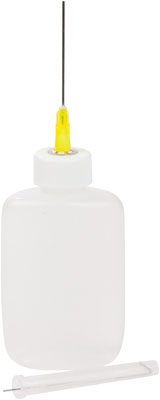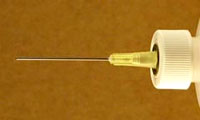

FINELINE APPLICATOR
Guaranteed to Never Stop Flowing
Unique non-clogging, air-tight Cap|Wire system keeps the most viscous liquids flowing smoothly.
Use with acrylics, inks, gutta, masking fluid, watercolors, oil paints, silk dyes, stains, henna, water-based glues and glazes.
The long stainless steel needle offers an easy-to-use, precise placement, free-flow never clogging system for all of the above liquids. After each use, push Cap|Wire into the needle and secure. When removing the Cap|Wire, twist and pull upward, bit by bit, until removed from the bottle.
Unlimited possibilities - unlimited creativity. Create complex designs, endless lines, precise dots.
1.25 oz. flat-shaped bottles make for easier handling and control.
Available in two needle sizes: 20 gauge (.5mm) and 18 Gauge (.8mm).



Masquepen w/ 8mm nib
"I found the new Masquepen from Cruddas Innovations a delight to use. At last there's a masking fluid with a sensible and workable strength. The Masquepen is so simple to use. Pull off the cap and wipe the stainless steel. Hold like a pen and use for curved, thick or thin lines, dots - indeed any statement you wish. I have used it successfully both under layers, and on top of inks, watercolours and washy acrylic paints. There's no waste, just remember to clean the prong before re-inserting it into the nylon nib. It's very portable, and does not leak, so you can keep it with your other art materials, whether in the studio or on location."
Wendy Jelbert
"I guess the stuff isn't really rubber cement but it's very similar (I have used rubber cement on big jobs with very porous surfaces (bone or leather) because it's cheaper). The stuff I have in my art trunk is Masquepen Artist's Masking Fluid and it's the only good thing I got from my watercolour class. You put the masking fluid on areas you want to keep white when doing colour washes. The stuff peels off the medium like rubber cement off a credit card, leaving behind a perfectly clean and crisp white space. I started using it on pencil sketches to protect small white spaces that would be challenging/impossible to touch up with an eraser. I can't keep my paws the surface when I work so I tend to smudge things especially with softer pencils or even colour pencils. I've never tried it on bristol board but I imagine it would be fine. I've never found it to stain but did lift the surface on a very loose raw paper.
Genghis Con